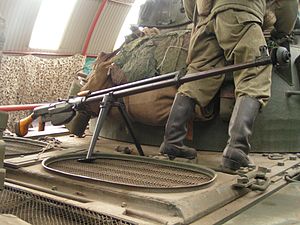PTRS
| PTRS-41 | |
|---|---|

PTRS
|
|
| Type | Anti-tank rifle |
| Place of origin | Soviet Union |
| Service history | |
| In service | 1941-Present |
| Used by |
Soviet Union North Korea China Sudan |
| Wars |
World War II, Korean War, Chinese Civil War, Syrian Civil War, War in Donbass |
| Production history | |
| Designer | Sergei Gavrilovich Simonov |
| Designed | 1938 |
| Produced | 1941–45 |
| Specifications | |
| Weight | 20.3 kg (46 lbs) |
| Length | 2100 mm (83 in) |
| Barrel length | 1219 mm (47 in) |
|
|
|
| Cartridge | 14.5×114mm |
| Action | Gas-operated; short stroke gas piston, vertically tilting bolt |
| Muzzle velocity | 1,013 m/s (3,323 ft/s) |
| Effective firing range | 800 m (874.9 yd) (against armored vehicles) |
| Maximum firing range | 1,500 m (1,640.4 yd) (against armored vehicles) |
| Feed system | 5-round (in clip) integral magazine |
The PTRS-41 or Simonov anti-tank rifle (Russian: ПротивоТанковое Ружьё Симонова) is the semi-automatic analog of the PTRD anti-tank rifle.
The PTRS-41 was produced and used by the Soviet Union during World War II. In the years between the World Wars, the Soviet Union began experimenting with different types of armour-piercing anti-tank cartridges. Finding the 12.7×108mm insufficient, they began development of what became the 14.5×114mm armour-piercing round. Rukavishnikov developed an antitank rifle () designated M1939 to accommodate this cartridge, but it didn't have large success because of some manufacturing issues, a sufficient number of more effective anti-tank guns in the Red Army, and high expectations about new German tank armour.
In 1941, the loss of huge amounts of anti-tank artillery created a need for a stop-gap anti-tank weapon, so famous USSR weapons designers such as Vasily A. Degtyaryov and Sergei G. Simonov designed two anti-tank rifles. Both were considered more simple and suitable to wartime production than an updated Rukavishnikov rifle. Simonov used elements of his 1938 design, a 7.62 mm automatic rifle.
The five-round magazine was loaded into the receiver and held under pressure by a swing magazine underneath. On firing the last round, the bolt is held open, and the magazine release catch can be operated only when the bolt is locked back. The gas-operated PTRS has a tendency to jam when dirty, and the 14.5 mm cartridge produces significant residue, blocking the gas port. The 14.5 mm armour-piercing bullet has a muzzle velocity of 1013 m/s and devastating ballistics. It can penetrate an armour plate up to 40 mm thick at a distance of 100 meters.
...
Wikipedia
